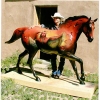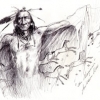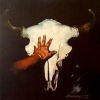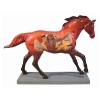
Kee, Andersen
The Artist behind "The Magician"... an Indian Horse Whisperer
Acknowledging his accomplishments in either the visual or the performing arts doesn't come easy to Andersen Kee. When you get him to talk about his movie credits - Dog Soldiers, The Little Big Horn, and most recently, Into the West - he speaks in a shy and soft-spoken voice.
"You don't really see much of me. I was riding hard in most of the fight scenes. In one scene I was dressed as a Cheyenne, in another a Sioux, and in another still I was Sitting Bull's bodyguard."
His voice becomes more animated when he describes the weather during one shoot. "When we were shooting The Little Big Horn the weather was bad. It was snowy, windy and cold. We had to go south to find ground that wasn't covered with snow, and instead of going barechested we wore buckskin shirts. They'd give us a five minute warning to peel everything off, jump on our horses and get ready to ride... and we'd pray the scene would only require one take."
In some of his films he's had speaking parts, but in that particular one he didn't. The way you could tell which warrior was Andersen was he was one of the few actors riding bareback at a full gallop. To understand how he acquired that ability you have to go back to his childhood on the Navajo Reservation, where his artistic talents were developed as well.
Andersen Kee grew up in Cottonwood, 25 miles west of Chinle. "Sometimes it shows up on the map, and sometimes it doesn't," he says. This is a place on the planet best described by Willa Cather, who wrote, "Elsewhere the sky is the roof of the world, but here the earth was the floor of the sky."
His father worked on the railroad but supplemented his income as a silversmith, while his mother Sadie was a weaver, when she wasn't busy raising 14 kids. Andersen was smack in the middle: lucky number 7. But he liked hanging out with his older brothers, which is where he learned to ride. "My dad had a herd of mustangs: at the most thirty head, at the least ten, and a few we kept around the homeplace. It was open range and it was the kids' job to go check on the herd. Being the youngest, my brothers got all the saddles so if I wanted to go along, which I always did, I had to ride bareback."
Just as much fun, and a lot easier, were the artistic pursuits. Taking a cue from his parents creativity and handiwork, Andersen would go out to a nearby cliff and break off a flat section of rock on which he would scratch images with a nail or sharp piece of glass. In the way he could rub the images off the surface and paint something else, the sandstone slabs were like a chalkboard.
He didn't speak English until he was in the fifth grade, nor did he grow up having much of a feeling for Navajo history. But when the topics came up in middle school, he couldn't get enough of either the language or the history classes and they became the focus of his education. It was during this same time period that his interest in history began to manifest itself in drawings and paintings, which led to a lifelong devotion to Native American subject matter.
Encouraged by a high school art teacher, he applied and was accepted into the prestigious Institute of American Indian Arts in Santa Fe. Next he completed two years at the California College of Arts and Crafts. Over one summer he worked at the Colter Bay Indian Arts Museum, giving tours, guiding nature walks and conducting demonstrations of Native arts and crafts. Feeling it was time to try find his place in a genuine arts community, he moved to Taos, New Mexico, where he has lived for the past twenty-four years, "making art."
Although he paints Southwestern scenes and portraits that draw on his Navajo background, most of his canvases depict Plains Indians from the late 1800s. The way the Plains tribes dressed, their use of feathers, colors, bead and quillwork, gives his imagination an endless supply of images to draw from. But making a living from art is not all that easy, and to expand his line of offerings, he turned to silver jewelry.
It was silversmithing that paid for his European vacation a few years back. Recalls his good friend and traveling companion, Tony Whitecrow, "We checked into this hotel, and Andersen would do water colors and silver jewelry up in the room, and I'd go down to the bistro, sit at the bar and lay out his work on my kerchief. People would come over and ask "What's up?" I'd tell them, "My Navajo partner is up in the room painting and making jewelry," and we came home with more money than we took."
It was in painting his life-size Pony titled "The Magician" that Andersen had an opportunity to combine his love of horses with his art. All his life he's heard stories of "Indian horse whisperers," members of a tribe with a special ability to communicate with horses. The warrior on his Pony does not come from one particular tribe, but represents them all. And in opening his elk skin robe and releasing a herd of brightly colored Ponies that circle around and are gathered on the back side of the horse, on the back of the robe, where they are rendered in a ledger art style, Andersen is expressing the traditional belief that "Everything in life goes round in a circle."
Painted Pony figurines by Andersen Kee:
- The Magician
Additional Information
Where do you live?
Taos, New Mexico. On historic LeDoux Street. Down the street from RC Gorman's gallery.
Where do you do your art?
In a small shop at the El Torreon hacienda, not far from the plaza in Taos. There are three other shops and a restaurant called Texas Barbeque.
Who is your biggest artistic influence?
Rembrandt. I haven't really studied him, and our subject matter is certainly different, but the paintings of his that I've seen strive for the same effects through the use of dark backgrounds and strong highlights.
What's your favorite song?
If I had a jukebox it would have all the songs by John Lee Hooker and the blind, black singer Robert Bradley and the Black Water Surprise.
What's your favorite color?
Earth tones. Not too bright, not too dark.
Who is your hero?
My parents. Everything I know came from them - their lessons, their example.
Favorite words of advice?
One word: Hozho. It means "harmony" in Navajo. Keep everything in balance. It's something that as humans, we don't do so well.




